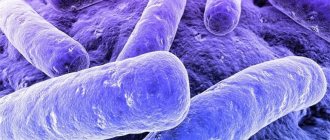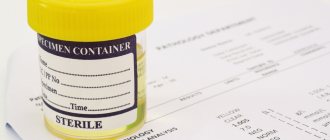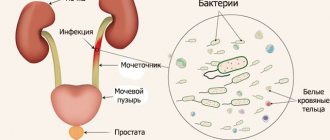Author
Boluchevsky Dmitry Nikolaevich
Chief physician
Leading doctor
Urologist
until September 30
We're giving away RUR 1,000 for all services per visit in September More details All promotions
Urinalysis according to Nechiporenko
is a laboratory diagnostic method that allows you to determine the condition of the kidneys and urinary tract, in particular, to identify hidden inflammation.
The Nechiporenko analysis is used not only to establish a diagnosis. It can be used to monitor the progress of treatment.
Detailed description of the study
Urinalysis according to Nechiporenko is carried out using microscopy. It allows you to count the number of red blood cells, leukocytes and casts of various types, which are used to diagnose kidney diseases and assess their condition.
Urinalysis according to Nechiporenko reveals the presence of various types of casts, erythrocytes and leukocytes in the urine. Their number is calculated in 1 ml of sediment. Normally, the renal glomeruli do not allow blood cells to pass into the urine, but in some diseases this barrier is damaged and they can be detected.
Cylinders are protein formations that appear when the properties of urine change. They can be of different types:
epithelial - from the epithelium of the kidney tubules; granular - destroyed epithelium and red blood cells; waxy - degenerated granular; hyaline - from the protein hyaline. Based on which type was detected, kidney disease can be assumed and the patient can be referred for further examination.
Urinalysis according to Nechiporenko: indicators and norms
Leukocytes
- white blood cells. They perform a protective function by producing antibodies and absorbing bacteria. An increased number of white blood cells means that the body is reacting to an existing source of inflammation. The norm for the Nechiporenko test: up to 2000 per 1 ml of urine.
Red blood cells
– red blood cells (they give the color to blood). Their function is to transport oxygen, and they should not be present in significant quantities in urine. An increased number of red blood cells is called hematuria (can be translated as “blood in the urine”). The presence of blood in the urine in some cases is obvious (that is, detected visually), but a slight increase in the number of red blood cells (hidden hematuria) can only be recognized by laboratory methods. The norm for the Nechiporenko test: up to 1000 red blood cells per 1 ml of urine.
Cylinders
- these are casts, that is, stuck together, compressed elements that appear only in the presence of protein. The protein, coagulated in the acidic environment of urine, forms an adhesive base that unites other elements. Casts arise in the renal tubules. Their appearance in the urine directly indicates kidney pathology, since in a healthy person protein should not get into the urine. The norm for the Nechiporenko test: no more than 20 cylinders per 1 ml of urine.
Bacteria
- Normally they should not be in the urine.
General urine analysis
“General or clinical urine analysis” is usually called a study of material carried out within the framework of a healthcare medical institution - a laboratory. Thus, all the necessary characteristics of urine are assessed, and through its use microscopy of the sediment can be considered.
When visiting a therapist, a sick person will be advised to take the appropriate tests: urine and blood. A laboratory and clinical study carried out with a portion of urine will help evaluate:
- The color of the urine submitted for analysis.
- Specific gravity.
- Degree of transparency.
- Acidity level (ph balance).
Urinary examination allows you to determine epithelial cells, the presence of red blood cells, leukocytes, casts and bacteria, if any.
An analysis of this kind is prescribed to determine a huge number of diseases. It allows you to timely diagnose:
- Kidney diseases (nephritis, amyloidosis, tumors),
- Identification of primary signs of diseases (this is the reason why this test is prescribed during a preventive examination).
How to properly collect urine
Urine for analysis must be collected in the morning - the main condition. Before collection, you should perform a hygienic toilet of the genitals. It is necessary to collect the morning portion of urine in a clean and always dry container and mix it. From the total liquid, it is worth pouring 50 milligrams of urine into a sterile medical jar intended for this analysis. It is available to anyone, as it is sold in a pharmacy. A general urine test is valid for 2 hours .

General analysis - normal
Reminder for collecting urine tests
Technique for collecting urine for general analysis
After toileting the external genitalia, morning urine is collected for general analysis in a disposable pharmaceutical container of at least 50 ml.
The urine container must be delivered to the laboratory between 7:30 and 10 am.
Technique for collecting urine analysis “according to Nechiporenko”
After toileting the external genitalia, collect an AVERAGE portion of morning urine with a volume of at least 20 ml. The first and last portions of urine are poured into the toilet into a disposable pharmaceutical container.
The urine container must be delivered to the laboratory between 7:30 and 10 am.
Technique for collecting daily urine
Urine is collected over 24 hours. In the morning before urine collection
toilet the external genitalia. The first portion of urine in the morning is released into the toilet and the time of urination is noted. Next, all urine during the day (until the same time the next day) should be collected in one container (usually a 3-liter jar with a lid is used, which is stored in the refrigerator).
After collecting the material, you must independently assess the total volume of urine collected. After which the urine is mixed and part of it (at least 100 ml) is poured into a special container. It is this container that is delivered to the laboratory (the entire volume of urine does not need to be delivered) from 7-30 to 10 am.
When submitting urine to the laboratory, it is necessary to indicate from what time to what time the urine was collected; what is the total volume of urine?
It is allowed to collect urine up to 12 hours in advance.
Technique for collecting urine for bacteriological culture
Prepare a sterile container for collecting urine. Wash your hands with soap, then thoroughly wash your external genitalia.
- after washing, take a sterile container to collect urine, open the lid so as not to touch the inner surface of the lid and container;
- release the first stream of urine into the toilet, hold urination, place a container, release urine into the container in an amount of at least 10 - 15 ml, flush the remaining portion of urine into the toilet. Carefully close the lid of the container without touching the edges of the neck.
Hypothermia, overheating and spilling urine are not allowed!
Analysis is accepted strictly from 7:30 to 8:45 (except weekends)
Technique for collecting urine for glucosuric profile
Daily urine is collected in three clean separate jars, and the time of urine collection is signed on each jar.
- from 6-00 to 14-00.
- from 14-00 to 22-00.
- from 22-00 to 6-00.
The amount of urine collected is measured in ml.
The amount of urine collected is measured. The amount is indicated in ml.
Urine is poured from each jar into a separate plastic container (at least 50 ml), and the time of urine collection is signed on each container.
Containers with urine must be delivered to the laboratory between 7:30 and 10 a.m. (except weekends).
Urine collection technique for the Rehberg test
The Rehberg test involves collecting urine and blood samples. The day before, exclude physical activity, alcoholic drinks, strong tea, spicy and fatty foods.
Urine is collected over 24 hours. In the morning, before collecting urine, toilet the external genitalia. The first portion of urine in the morning is released into the toilet and the time of urination is noted. Next, all urine during the day (until the same time the next day) should be collected in one container (usually a 3-liter jar with a lid is used, which is stored in the refrigerator).
After collecting the material, you must independently assess the total volume of urine collected. After which the urine is mixed and part of it (at least 150 ml) is poured into a special container. It is this container that is delivered to the laboratory (the entire volume of urine does not need to be delivered) from 7-30 to 10 am.
When submitting urine to the laboratory, it is necessary to indicate from what time to what time the urine was collected and the total volume of urine. Indicate your height, weight and amount of liquid drunk during the day.
When delivering a urine test to the laboratory, it is necessary to donate blood on that day to determine the level of creatinine (fasting)
Urine collection technique according to Zimnitsky
During the study, daily, daytime and nighttime diuresis and the relative density of urine in each of the 3-hour portions are determined.
Urine collection for the Zimnitsky test is carried out at certain hours during the day. The test is carried out with normal drinking and nutrition.
In order to correctly collect the required material you need:
- 8 clean containers with a lid, each holding a volume of 200 ml - these can be obtained from the hospital laboratory (label the time of urine collection on each)
- A watch, preferably with an alarm (urine collection should occur at certain hours)
- A notepad for recording the liquid consumed during the day (including the volume of liquid received with soup, milk, etc.)
How to collect urine for research according to Zimnitsky?
At 6 o'clock in the morning you need to empty your bladder into the toilet. Throughout the day, every 3 hours you need to empty your bladder into jars (if one container is not enough, take an additional container)
Strictly observe a 3-hour gap between urine portions!
- from 6 to 9 am - collect all urine excreted over the next 3 hours into the first container;
- from 09 to 12 o'clock - to the second container;
- from 12 to 15 o'clock - on the third;
- from 15 to 18 hours - on the fourth;
- 18 to 21 o'clock - at five;
- from 21 to 24 o'clock - at six;
- from 24 to 03 o’clock – at seven o’clock;
- from 03 to 06 a.m. fill the last, eighth container.
Jars to be filled must be kept cool and closed (in the refrigerator). The next morning, you must take all the jars with their contents to the laboratory, additionally providing records of the liquid consumed during the day.
Preparation for urine collection
On the eve of urine collection for analysis, doctors strongly do not recommend actively consuming alcoholic beverages, not engaging in active sports, and emotional stress should also be avoided. Patients should not eat those vegetables and fruits that can affect the color of urine. Drugs that have a diuretic effect are also prohibited on the eve of a general urine test.
Doctors note that it is not advisable to take the test for women during menstruation and for patients who have undergone an examination method such as cytoscopy.
Analysis indicators
Many people are interested not only in how the Nechiporenko urine test is performed, but also in what it shows. Deviation from the norm towards an increase in the number of leukocytes indicates the presence of inflammatory and infectious processes. In this case, to make a diagnosis, an additional test for the presence of pathogenic microorganisms in the urine is prescribed. This will allow you to buy the necessary medications in accordance with the doctor’s recommendations and carry out effective therapy. A small number of white blood cells in the urine indicates normal functioning of the immune system.
Confirmation of a large number of red blood cells in the urine indicates damage to the urinary system. The main function of red blood cells is to transport oxygen through tissues. They should be present in the urine in minimal quantities. Exceeding their permissible amount may indicate the development of serious diseases, in particular the following:
- Tumor processes in the kidneys.
- Kidney tuberculosis.
- Urolithiasis.
- Glomerulonephritis.
- Intoxication of the body.
Also an important indicator of urine analysis according to Nechiporenko is the number of cylinders. They are special casts that occur when protein is present in the urine. This substance, under the influence of an acidic environment, coagulates, forming compressed elements called cylinders. Their number may be insignificant during intense physical activity and emotional stress. But a large number indicates the development of serious pathologies: glomerulonephritis, renal failure, kidney tuberculosis, etc. In addition, exceeding standard indicators may indicate the risks of rejection of a donor kidney.
The norm is considered to be a quantity not exceeding the following values:
- For red blood cells 1000/ml.
- For leukocytes 2000/ml
- For 20/ml cylinders
Indications for testing
The main indication for prescribing a urine test according to Nechiporenko for adults and children is the detection of deviations in the results obtained after a general urine test. The study can confirm the development of a certain pathology or classify deviations from the norm as random.
Indications for urine analysis according to Nechiporenko are the appearance of symptoms that may indicate the development of serious pathologies. This is, first of all, cloudiness of the urine, as well as a change in its color and smell. The study is also prescribed in the following cases:
- If you experience pain in the lumbar region, which may indicate kidney problems.
- When changing the frequency of urination and the amount of urine.
- If blood is detected in the urine.
- For systemic diseases that increase the risk of renal dysfunction.
- During preventive examinations.
Mandatory tests include urine analysis according to Nechiporenko during pregnancy. It allows you to promptly detect malfunctions in the functioning of the urinary system. Thanks to this, it will be possible to purchase the necessary products at an affordable price to support a woman’s body while bearing a child.
Indications for use of the analysis
This examination method will be recommended to all patients for:
- A preventive measure that applies to all patients who consult doctors, regardless of what diagnosis is expected for them,
- Detection of kidney diseases and problems associated with the normal functioning of the urinary tract,
- Annual examination,
- Assessing the course of the disease and determining effective treatments that the patient receives,
Persons who have had a streptococcal infection (usually tonsillitis or scarlet fever) especially need to be tested. Such patients will have to undergo a general urine test one to two weeks after complete recovery.
Peculiarities
The analysis involves examining urine sediment. To do this, the biomaterial is poured from a sterile container into a test tube and mixed. After this, the vessel is placed in a centrifuge and the sediment is separated. After this, it is carefully examined in a volume of 1 ml in a chamber equipped with a special counter. The obtained data is multiplied by the provided coefficients to correctly reflect the level of structures.
Violations of the rules for urine collection most often lead to unreliable results. The risk of data distortion increases when storing biomaterial in non-sterile containers.









